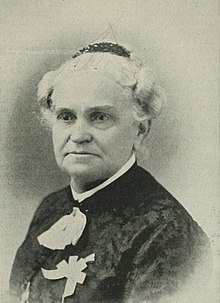Eliza Daniel Stewart (April 25, 1816 – August 6, 1908) was an American early temperance movement leader.[1] She sometimes referred to herself as "Mother Stewart".[2]
Eliza Daniel Stewart | |
|---|---|
 | |
| Born | April 25, 1816 Piketon |
| Died | August 6, 1908 Hicksville |
| Signature | |
Biography
editEliza Daniel Stewart was born in Piketon, Ohio on April 25, 1816.[1][3]
Stewart began her career in public service during the American Civil War, working with the Soldiers' Aid Societies and the United States Sanitary Commission.[4]
In 1872, Stewart delivered a lecture entitled "The Liquor Traffic and How to Avoid It".[5] Afterward, the editor of The Springfield Republic suggested she encourage the wives of heavy to prosecute saloonkeepers under the Adair law.[5] The Adair law provided that "a wife, child, parent, guardian or employer of an intoxicated person, who has been injured in person, property, or means of support by such intoxication, could sue the individual who by furnishing the requisite liquor, was said to have 'caused' the intoxication, for damages both exemplary and actual".[5] Days later, Stewart made an impassioned plea on behalf of a destitute woman in an Adair case. The court awarded the woman $100 plus costs.[5] For her second Adair case in October 1873, Stewart took a more active room in the courtroom and the plaintiff was awarded $300.[5]
Stewart was a key figure in the Women's Crusade of 1873–74. The Crusades began in Hillsboro, Ohio a speech given by Dr. Diocletian Lewis on December 23, 1873.[6] Lewis told the story of how his mother, distressed by her husband's drinking, appealed to the owner of the local saloon to cease selling liquor by praying with a group of other women.[5] The women were successful and the saloonkeeper closed his business.[5] In response to this story, the women of Hillsboro marched through the town, stopping at every saloon (approximately twenty of them) and praying for the souls of the barkeepers and their patrons.[7] The women asked the owners to sign a pledge to no longer sell alcohol.[7] By 1875, more than 130 other communities around the state had also had experienced marches–a period often known locally as the “Ohio Whiskey War".[7]
Richard H. Chused described the Crusade as follows: "Leaving the sanctuary of their homes, they carried an aura of moral responsibility and upright character with them as they entered bars filled with smoking and imbibing men and prayed on the streets in front of drinking establishments for weeks on end. Many men were incredulous that the respectable women of southern Ohio were capable of organizing daily prayer sessions and well-orchestrated marches into male domains".[6]
Stewart founded the Women's Temperance League of Osborn, Ohio, in 1873.[4] Stewart helped to found the Woman's Christian Temperance Union in 1874 and the Osborn organization became the first local chapter of the new national organization.[4][8]
She visited the United Kingdom in 1876, and helped organize the British Women's Temperance Association.[2]
She died at her home in Hicksville, Ohio on August 6, 1908.[9]
References
edit- ^ a b McHenry, Robert (January 1, 1980). Famous American Women: A Biographical Dictionary from Colonial Times to the Present. Courier Corporation. ISBN 9780486245232.
- ^ a b Teaching, Mitchell Shelton, The Harvey Goldberg Center for Excellence in. "Woman's Crusade of 1873-74 | Temperance & Prohibition". prohibition.osu.edu. Retrieved April 8, 2017.
{{cite web}}: CS1 maint: multiple names: authors list (link) - ^ The National Cyclopaedia of American Biography. Vol. VII. James T. White & Company. 1897. pp. 37–38. Retrieved February 1, 2021 – via Google Books.
- ^ a b c "Eliza D. Stewart - Ohio History Central". www.ohiohistorycentral.org. Retrieved April 8, 2017.
- ^ a b c d e f g Masson, Erin M. (1997). "The Women's Christian Temperance Union1874-1898: Combating Domestic Violence". William & Mary Journal of Women and the Law. 3.
- ^ a b Chusad, Richard H. (2009). "Courts and Temperance "Ladies"". Yale Journal of Law and Feminism. 21.
- ^ a b c "The Prohibition Era Begins…". www.ohiohistoryhost.org. Retrieved April 8, 2017.
- ^ Black, Ros (March 28, 2015). Scandal, Salvation and Suffrage: The Amazing Women of the Temperance Movement. Troubador Publishing Ltd. ISBN 9781784628239.
- ^ "Founder of W.C.T.U. Dead". Fall River Daily Evening News. Springfield, Ohio. August 7, 1908. p. 2. Retrieved February 1, 2021 – via Newspapers.com.
Further reading
edit- "Woman's Crusade of 1873-74". Temperance & Prohibition. Department of History, College of Humanities, The Ohio State University. Archived from the original on August 16, 2007. Retrieved September 8, 2007.
- "Eliza Daniel Stewart". Ohio History Central. Ohio Historical Society. Retrieved September 8, 2007.